April 18, 2012 7:00 AM CDT
The most reliable test of stonemasonry’s longevity is to look at any monument or heritage structure in the world––such as India’s Taj Mahal, France’s Chartres Cathedral, and Italy’s Roman Coliseum, all of which were constructed of stonemasonry. These structures were built centuries ago and are still standing today.
Masonry has a useful life of 500 years when compared to structures made of steel or reinforced concrete, whose lifecycle can be anywhere between 30 to 100 years. Natural stone, whether granite, marble, travertine, limestone, or slate, will not retain water or produce efflorescence over time. It is heat-resistant and, therefore, provides exceptional fire protection when likened to other manufactured products. Additionally, in the event of a natural disaster, masonry walls are more resistant to projectiles, such as debris from hurricanes or tornadoes.
Achieving a durable, elegant appearance in any building project begins with product selection. While there are numerous artificial stone manufacturers that try to attain a natural appearance in their product, it is virtually impossible to attain the inherent beauty natural stone offers, and few artificial products match up to their natural counterparts with respect to resilience. Natural products can be impervious to chemicals that might be found on a project site, unlike artificial materials that may fade, crack, or stain even without chemical introduction. Further, due to natural stone’s durability, it is much easier to clean and, therefore, there is less worry of defacing the product with abrasive chemicals.
Popular belief is that natural stone is ideal for use on both older homes and newer ones. There is no greater reward found than in incorporating a portion of a home’s history into a new design that carefully considers the future while appreciating the past. There is also stone’s esthetic impact––not many materials can create pride quicker than walking into a home with a natural stonemasonry entranceway, floor, fireplace mantel, and surround.
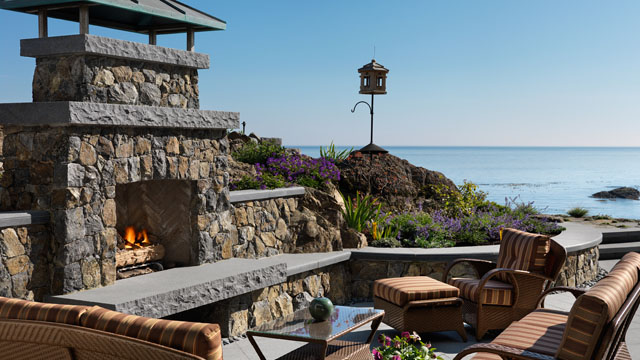
Natural stone also has other sustainable qualities, such as incomparable thermal insulating properties, and has reduced lifecycle costs since no painting is required. Artificial stone, on the other hand, is painted, dyed, or both in the production process. Therefore, as it weathers and begins to age, the colour also fades. This fading happens far quicker for artificial stone exposed to the elements. When this happens, repainting, dyeing, and resealing is required to maintain the desired look.
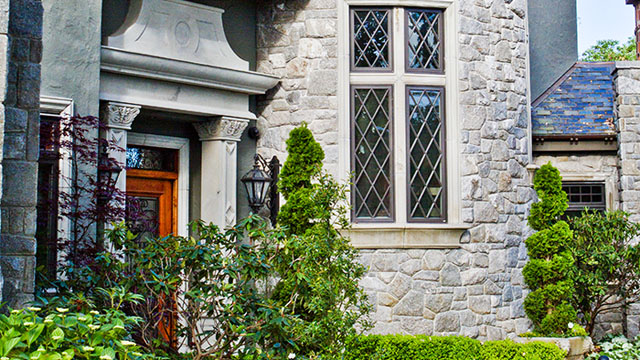
Technological advancements have had special implications on stone quarries. Advances in quarrying technology have eased the challenge of extracting natural stone and have improved productivity levels, resulting in more cost-efficient natural stone. During stone extraction within the quarry process, equipment using modern technology is able to precisely cut the stone, thus avoiding any damage. The decision to automate a stone quarry is brought about by a necessity for consistency and to eliminate human error.
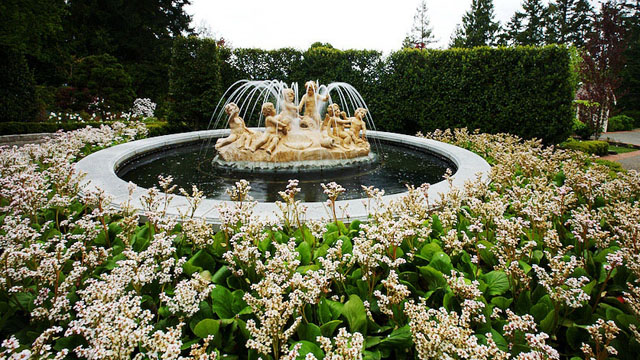
Stone-carving is an ancient activity first carried out by paleolithic societies––the ritual of turning stone into sculpture is in fact older than civilization itself. In the current age of expanding digital technologies, where the machine often excels over many factors of human endeavour, carving stone sculptures is one of the few examples of why the human hand is still superior to the machine.
Due to digital technologies, natural stone scultpures are now more accessible because of lower costs associated with having a machine cut multiple scultures in the time it would take an artist to hand-carve just one. Therefore, people that previously could not afford to purchase a natural stone sculpture now can.
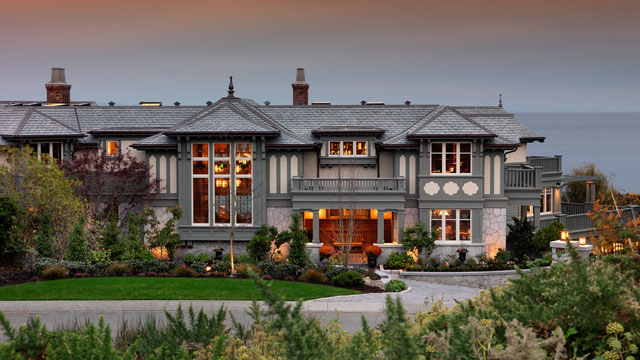
The use of natural stone replaces the need for concrete manufactured units. Consequently, it greatly reduces energy consumption because the amount of energy used to extract natural stone is inconsequential when compared to the amount of energy used to create and maintain artificial stone. From an environmental standpoint, cement production is one of the most energy-intensive of all industrial manufacturing processes. Roughly six per cent of total U.S. energy consumption goes into cement production, which is a remarkable amount given the fact that in dollar value, cement represents only about 0.6 per cent of the gross national product (GNP). Thus, cement production is approximately 10 times as energy-intensive as the U.S. economy in general.
Cement manufacturing also releases carbon dioxide (CO2) into the atmosphere, both directly when calcium carbonate is heated, producing lime and CO2, and also indirectly through the use of energy because its production involves CO2 emission. The cement industry is the second largest CO2-emitting industry behind power generation in the world. It also produces about five per cent of global manmade CO2 emissions, of which 50 per cent is from the chemical process, and 40 per cent from burning fuel. Therefore, in many ways, concrete brick and block has a very high cost on the environment.
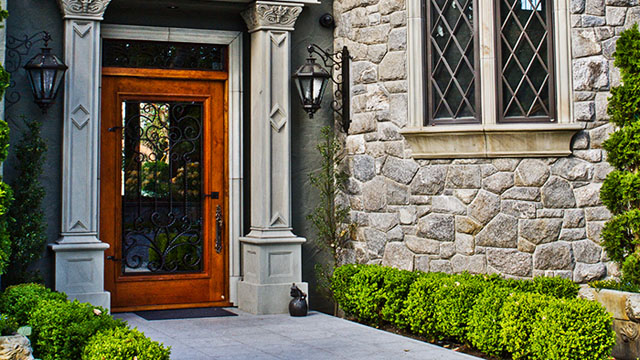
Granite has been linked by some to the potentially harmful gas, radon. However, a cause and effect relationship between granite and radon has not been established. The U.S. Environmental Protection Agency (EPA) has stated that:
Due to its innately warm colours, it adds a sophisticated element to any area in which it is installed. Additionally, many marbles are well-suited for wet areas, which extend the versatility of this material to include tub decks and showers. It should be noted marble is vulnerable to acids and other weathering elements; therefore, exterior applications are generally limited to white marble with some exceptions.
Preserving the declining art of stonemasonry
One of the earliest crafts in civilization’s history
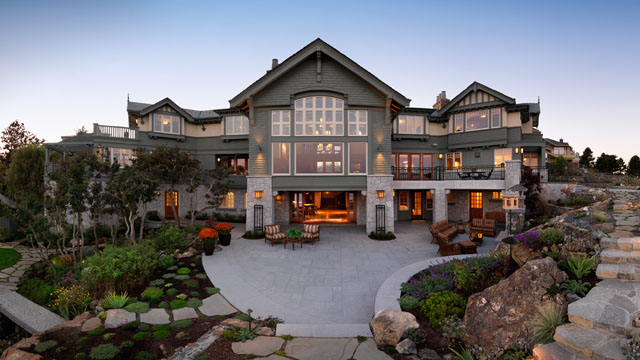
Natural stone is ideal for use on both older homes and newer ones.
Stonemasonry is one of the earliest crafts in civilization’s history. Unfortunately, the ancient skills that built some of the world’s most magnificent churches, monuments, sculptures, and homes are now dying out. In medieval times, unions of stonemasons were commonplace. Now, with modern building practices and the varying materials available for use, the craft is exceedingly in short supply––largely due to the fact that as things began to shift in the global economy, artificial and cultured stone became more cost-effective and time-efficient.The most reliable test of stonemasonry’s longevity is to look at any monument or heritage structure in the world––such as India’s Taj Mahal, France’s Chartres Cathedral, and Italy’s Roman Coliseum, all of which were constructed of stonemasonry. These structures were built centuries ago and are still standing today.
Masonry has a useful life of 500 years when compared to structures made of steel or reinforced concrete, whose lifecycle can be anywhere between 30 to 100 years. Natural stone, whether granite, marble, travertine, limestone, or slate, will not retain water or produce efflorescence over time. It is heat-resistant and, therefore, provides exceptional fire protection when likened to other manufactured products. Additionally, in the event of a natural disaster, masonry walls are more resistant to projectiles, such as debris from hurricanes or tornadoes.
Achieving a durable, elegant appearance in any building project begins with product selection. While there are numerous artificial stone manufacturers that try to attain a natural appearance in their product, it is virtually impossible to attain the inherent beauty natural stone offers, and few artificial products match up to their natural counterparts with respect to resilience. Natural products can be impervious to chemicals that might be found on a project site, unlike artificial materials that may fade, crack, or stain even without chemical introduction. Further, due to natural stone’s durability, it is much easier to clean and, therefore, there is less worry of defacing the product with abrasive chemicals.
Popular belief is that natural stone is ideal for use on both older homes and newer ones. There is no greater reward found than in incorporating a portion of a home’s history into a new design that carefully considers the future while appreciating the past. There is also stone’s esthetic impact––not many materials can create pride quicker than walking into a home with a natural stonemasonry entranceway, floor, fireplace mantel, and surround.

The outdoor fireplace and patio are made from natural stone. Natural stone copings cover the stone walls, and natural stone slabs were used for the hearth.
Sustainable qualities of natural stone
The major difference between using natural stone for landscaping projects or in a home versus using synthetic materials is that stone lasts almost indefinitely. Since most artificial stone is made of cement, it typically lasts as long as any cement will—about 30 to 50 years. Most artificial stone manufacturers provide a 30-year warranty on their products. However, a stone-faced home or retaining wall, if built properly, will endure for centuries.Natural stone also has other sustainable qualities, such as incomparable thermal insulating properties, and has reduced lifecycle costs since no painting is required. Artificial stone, on the other hand, is painted, dyed, or both in the production process. Therefore, as it weathers and begins to age, the colour also fades. This fading happens far quicker for artificial stone exposed to the elements. When this happens, repainting, dyeing, and resealing is required to maintain the desired look.

The house features hand-crafted natural stone for the window trims, entranceway, and moldings.
Stone formation and extraction
The formative process for natural stone begins millions of years deep beneath the Earth’s surface. A combination of heat and pressure underneath the ground creates blocks of natural stone. As the Earth’s crust begins to grow and erode, it pushes minerals up from its core, forming massive rock deposits––referred to as quarries. Geologists then locate these quarries and the extraction process begins. Before arranging the stone to form a structure, a quarryman splits veins or sheets of rock, and extracts the resulting stone blocks from the ground.Technological advancements have had special implications on stone quarries. Advances in quarrying technology have eased the challenge of extracting natural stone and have improved productivity levels, resulting in more cost-efficient natural stone. During stone extraction within the quarry process, equipment using modern technology is able to precisely cut the stone, thus avoiding any damage. The decision to automate a stone quarry is brought about by a necessity for consistency and to eliminate human error.

A fountain sculpture was carved out of one piece of natural stone.
The carving process
When individuals think of stonemasonry, an image of a mason arranging and setting stones together with mortar comes to mind. However, the job of a stonemason is much more complex than just placing stone together. Stone installation is an intricate art; the mental aptitude it requires to endure a project for two or three years and turn simple stone into a beautiful and truly unique piece of art is enormous.Stone-carving is an ancient activity first carried out by paleolithic societies––the ritual of turning stone into sculpture is in fact older than civilization itself. In the current age of expanding digital technologies, where the machine often excels over many factors of human endeavour, carving stone sculptures is one of the few examples of why the human hand is still superior to the machine.
Due to digital technologies, natural stone scultpures are now more accessible because of lower costs associated with having a machine cut multiple scultures in the time it would take an artist to hand-carve just one. Therefore, people that previously could not afford to purchase a natural stone sculpture now can.

The house showcases hand-split natural stone roofing. Natural stone wall claddings and pillars were also used, and for the driveway and pathways, natural cobblestone and tile were used.
Natural versus artificial stone
Most types of artificial stone are concrete aggregate poured into forms and casts, then dyed to look like stone. As a result, it does not cut like natural stone and can easily chip, revealing a concrete interior. It also has the propensity to discolour in strong sunlight. As a result, it should not be used in bright, exterior locations exposed to prolonged sunlight.The use of natural stone replaces the need for concrete manufactured units. Consequently, it greatly reduces energy consumption because the amount of energy used to extract natural stone is inconsequential when compared to the amount of energy used to create and maintain artificial stone. From an environmental standpoint, cement production is one of the most energy-intensive of all industrial manufacturing processes. Roughly six per cent of total U.S. energy consumption goes into cement production, which is a remarkable amount given the fact that in dollar value, cement represents only about 0.6 per cent of the gross national product (GNP). Thus, cement production is approximately 10 times as energy-intensive as the U.S. economy in general.
Cement manufacturing also releases carbon dioxide (CO2) into the atmosphere, both directly when calcium carbonate is heated, producing lime and CO2, and also indirectly through the use of energy because its production involves CO2 emission. The cement industry is the second largest CO2-emitting industry behind power generation in the world. It also produces about five per cent of global manmade CO2 emissions, of which 50 per cent is from the chemical process, and 40 per cent from burning fuel. Therefore, in many ways, concrete brick and block has a very high cost on the environment.

Sandstone tile was also used for the entranceway and natural stone for the wall cladding.
Multiple uses of natural stone
When one thinks of stone, its use in famous buildings worldwide most likely first comes to mind. However, few people perhaps realize natural stone in some form exists in the world around us and individuals encounter it hundreds of times throughout the day. From a geological perspective, there are hundreds of natural stones; commercially, natural stone is characterized in 10 different categories:- granite;
- limestone;
- marble;
- onyx;
- quartzite;
- sandstone;
- serpentine;
- slate;
- soapstone; and
- travertine.
Granite
Granite is the most commonly used stone in newer homes for kitchen countertops, floors, and other heavily used surfaces. Its ability to withstand heat and abrasion-resistant properties lend it to widespread use. In contrast to many synthetic materials that easily scratch, the solidity of the minerals comprising granite surpasses almost any utensils used on it, resulting in excellent scratch resistance. Therefore, the use of granite has skyrocketed in residential interior areas.Granite has been linked by some to the potentially harmful gas, radon. However, a cause and effect relationship between granite and radon has not been established. The U.S. Environmental Protection Agency (EPA) has stated that:
Some granite used for countertops may contribute variably to indoor radon levels. At this time, however, EPA does not believe sufficient data exist to conclude that the types of granite commonly used in countertops are significantly increasing indoor radon levels.Health Canada has released a similar statement, stating that:
High radon levels are not widespread in Canadian homes. Because of the very low risk level, Health Canada does not have specific recommendations for possible radiation hazards from granite countertops.
Marble
Marble is a metamorphic rock found in most of the world’s mountainous regions. It has a naturally random visual appearance and requires little maintenance, which is why it is popularly used for fireplace facings and hearths, foyers, tabletops, windowsills, walls, and countertops.Due to its innately warm colours, it adds a sophisticated element to any area in which it is installed. Additionally, many marbles are well-suited for wet areas, which extend the versatility of this material to include tub decks and showers. It should be noted marble is vulnerable to acids and other weathering elements; therefore, exterior applications are generally limited to white marble with some exceptions.
Sandstone and quartzite
Sandstone can be any mineralogy, but the overwhelming amount of it on the market is primarily quartz-based. Its durability and performance is not as greatly influenced by the sand-sized particles as it is to agents that bind them together. Exterior cladding is a common application of sandstone, although it is typically used in thicker sections than other stones due to its inferior bending strength. It is also used in cubic sections as sills, coping, water tables, and other exterior features.Slate and soapstone
Due to slate and soapstone’s chemical-resistant properties, the traditional use of both of these stones was in chemistry labs. Its longstanding application alone speaks volumes to the durability of both in these aggressive environments. With slate and soapstone being some of the softer materials, neither is known to be particularly high-abrasion or scratch-resistant, yet they are both commonly used for floors and countertops, most notably in commercial spaces. Slate is highly heat-resistant and, therefore, is often used in fireplace surrounds.Travertine and limestone
Limestone deposits exist in all continents. Despite the common reference to ‘travertine marble,’ it is actually a type of limestone. With the soft earth tones of these stones, decorators have many options when selecting complementary colours for their interior decor. Since these stones are of the softer variety when compared to other forms of natural stone, they have been a primary choice for intricately carved decorative home features and moldings as well as statuary.About the Authors
Hellen Diaz, BA, works in business communications for New Castle Stoneworks. She holds a business administration diploma and a degree in Professional communications from Royal Roads University (Victoria BC). Hellen can be reached via email at hellen@newcastlestoneworks.com.
Mike de Palma owns and operates New Castle Stoneworks — supplier and installer of premier natural stone products. He can be reached via e-mail at info@newcastlestoneworks.com.














